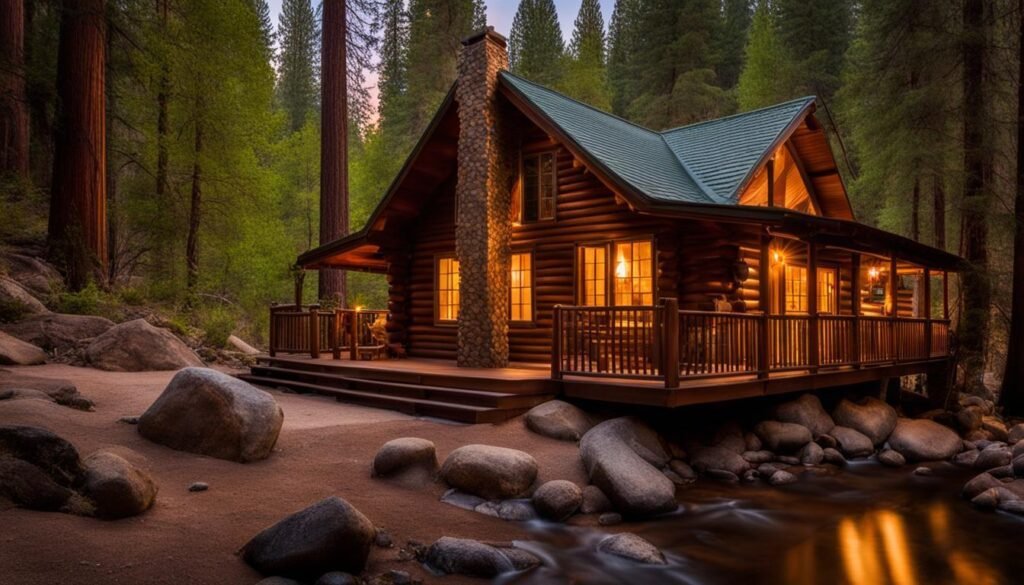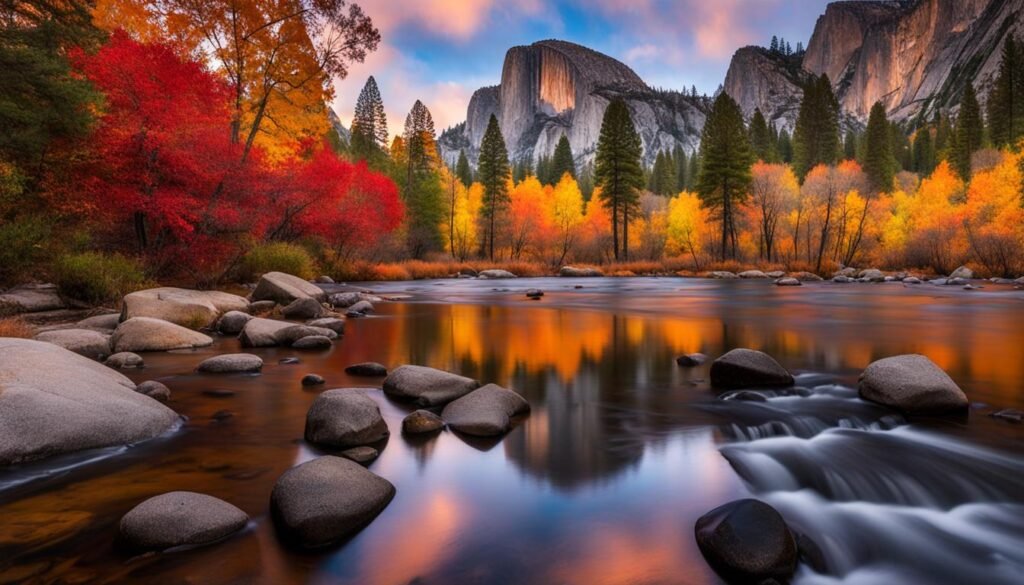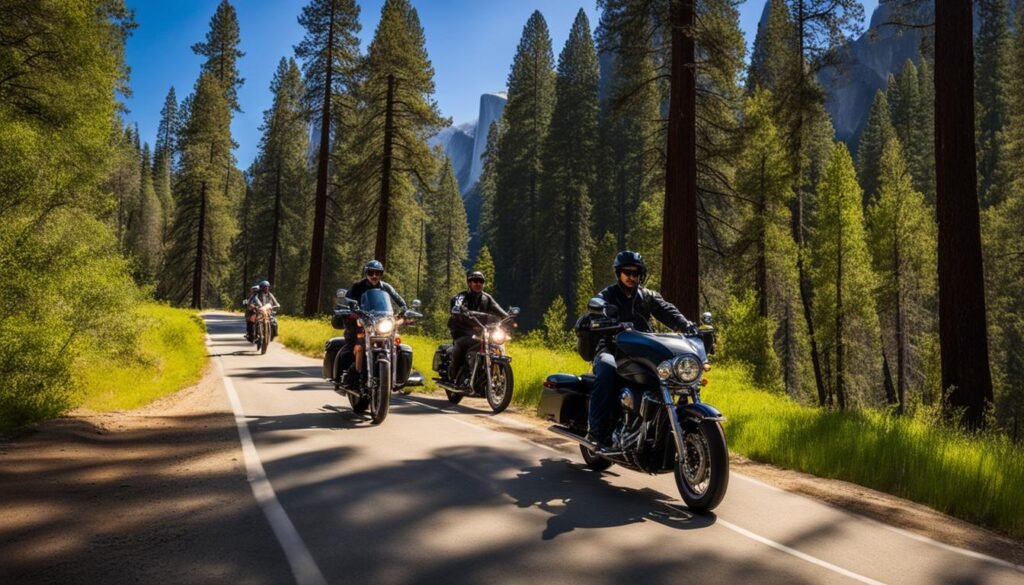Welcome to Yosemite National Park, a California gem that offers 1,200 square miles of natural beauty. As one of America’s most beloved national parks, Yosemite captivates visitors with its breathtaking landscapes and iconic sights. From towering granite walls to thundering waterfalls, this park is a feast for the senses. Join me on a journey through Yosemite’s wonders and discover the best tips and guides for an unforgettable adventure.
Key Takeaways:
- Yosemite National Park spans 1,200 square miles in California.
- It is a renowned national park known for its iconic scenery, including granite walls and majestic peaks.
- Yosemite is easily accessible from major cities like San Francisco and Los Angeles.
- The park offers a range of activities, from hiking to camping, suitable for all seasons.
- Exploring Yosemite’s attractions, such as Tunnel View and Mariposa Grove, is a must.
Yosemite Attractions: Exploring the Park’s Beauty
Yosemite National Park is a treasure trove of attractions that perfectly showcase the park’s unrivaled natural beauty. From iconic viewpoints to hidden gems, there’s something for everyone to discover and admire. Let’s dive into some of the must-see attractions that will leave you in awe of Yosemite’s majestic landscapes.
Tunnel View: A Panoramic Delight
One of the most breathtaking attractions in Yosemite is Tunnel View. As you approach the iconic viewpoint through the Wawona Tunnel, prepare to be captivated by a panoramic spectacle. From here, you’ll feast your eyes on the awe-inspiring beauty of Yosemite Valley, with monumental landmarks like El Capitan, Half Dome, and Bridalveil Fall dominating the scene. It’s a sight that epitomizes the grandeur of Yosemite and is a must-visit for every visitor.
Olmsted Point, Tenaya Lake, and Tuolumne Meadows: Natural Icons
Exploring Tioga Road unveils a series of natural wonders that deserve a spot on your Yosemite itinerary. Olmsted Point offers a unique vantage point, providing magnificent views of Half Dome and the surrounding granite landscapes. Tenaya Lake, with its crystal-clear waters and picturesque shoreline, is perfect for a relaxing picnic or a refreshing swim. And don’t miss the enchanting Tuolumne Meadows, a vast expanse of subalpine meadows bordered by majestic peaks, offering serene beauty and the chance to spot wildlife.
Hetch Hetchy: A Hidden Gem
While many visitors tend to overlook it, Hetch Hetchy is a true gem within Yosemite National Park. This lesser-known attraction is home to the mesmerizing Wapama Falls, which cascade into a pristine reservoir. Exploring the hiking trails in this area rewards you with stunning vistas, tranquil solitude, and far fewer crowds compared to other parts of the park.
Mariposa Grove of Giant Sequoias: Towering Giants
No trip to Yosemite would be complete without visiting the Mariposa Grove of Giant Sequoias. Here, you’ll encounter some of the largest and oldest trees on Earth. Walking among these towering giants, such as the famous Grizzly Giant and California Tunnel Tree, is an awe-inspiring experience that highlights the magnificence of nature’s creations.
Hiking: Embrace the Wilderness
To truly immerse yourself in Yosemite’s beauty, hiking is an absolute must. The park offers an extensive trail system that caters to hikers of all skill levels. One of the most popular hikes is the Mist Trail, leading you to the mesmerizing Vernal and Nevada Falls. The mist and the thundering sound of the water make for an unforgettable adventure and photo opportunities that will leave your friends in awe.
Camping: Become One with Nature
Camping in Yosemite allows you to fully embrace the park’s natural surroundings and spend more time surrounded by the stunning landscapes. Whether you prefer to camp in Yosemite Valley or venture further afield to Tuolumne Meadows or Wawona, you’ll have the opportunity to sleep under a star-studded sky and wake up to the sounds of nature.
Guided Tours: Expert Insight and Convenience
If you prefer a more structured approach to exploring Yosemite’s attractions, guided tours are available. These tours provide expert insight into the park’s geological wonders, cultural history, and hidden treasures. Joining a guided tour ensures that you don’t miss any highlights while benefiting from the knowledge of experienced guides.
Yosemite National Park’s attractions are a testament to the natural beauty and grandeur that has captivated visitors for generations. From breathtaking vistas to hidden gems, there’s an adventure waiting for you at every turn. So, embark on a journey through Yosemite and discover its unparalleled beauty for yourself.
Yosemite Lodging: Where to Stay in the Park
If you’re planning a visit to Yosemite National Park, it’s important to consider your lodging options to ensure a comfortable and enjoyable stay. Yosemite offers a range of accommodations for visitors, catering to different preferences and budgets.
In Yosemite Valley, you’ll find several campgrounds that provide a more immersive outdoor experience. Some campgrounds require reservations, while others operate on a first-come, first-served basis. Camping in Yosemite Valley allows you to be in the heart of the park, close to iconic landmarks and natural wonders.
If you prefer a more comfortable stay, there are hotels and lodges available in Yosemite Valley. The Ahwahnee and Curry Village are popular choices, offering cozy accommodations surrounded by the park’s natural beauty. These options provide convenient access to hiking trails, attractions, and dining facilities within the valley.
Outside of Yosemite Valley, there are additional lodging options in the gateway communities surrounding the park. Coulterville, Midpines, and Mariposa are some of the towns that offer a variety of accommodations. From budget-friendly motels to charming bed and breakfasts, there’s something for every traveler’s preferences and budget.
For visitors on a tighter budget, tent cabins and campsites outside of the park can be a cost-effective option. These accommodations still allow you to experience the natural surroundings of Yosemite while keeping costs down.
It’s important to plan ahead and make reservations, especially during peak travel seasons. Yosemite is a highly popular destination, and accommodation availability can be limited. By booking in advance, you can secure your preferred lodging and avoid any last-minute hassle.


When choosing your lodging in Yosemite, consider the proximity to attractions, facilities, and the level of comfort you desire. Whether it’s camping under the stars or staying in a cozy lodge, there’s a range of options to suit every traveler’s needs. Plan your stay and make the most of your time exploring the wonders of Yosemite National Park.
Best Time to Visit Yosemite: Seasonal Highlights
Yosemite National Park is a year-round destination, offering visitors unique highlights in each season. Whether you prefer warmer temperatures, stunning waterfalls, vibrant fall foliage, or a winter wonderland, there’s a perfect time to visit Yosemite based on your preferences.
Summer: Warm Days and Crowded Trails
In the summer months, Yosemite experiences warmer temperatures and longer days, making it the most popular time to visit. During this time, you can enjoy hiking, camping, and exploring the park’s diverse landscapes. However, be prepared for larger crowds and busier trails. To avoid the crowds, it is recommended to arrive early in the morning or visit on weekdays.
Spring: Peak Waterfalls and Melting Snow
Spring is a beautiful time to visit Yosemite as the park’s waterfalls reach their peak flow due to melting snow. Witness the breathtaking beauty of cascading waterfalls and enjoy the emerging wildflowers throughout the park. Spring offers comfortable temperatures and fewer crowds compared to the summer months, making it an ideal choice for nature enthusiasts.
Autumn: Cooler Temperatures and Vibrant Foliage
If you love the colors of fall, visiting Yosemite in autumn will not disappoint. Cooler temperatures create a pleasant atmosphere, and the park is adorned with vibrant fall foliage. Explore the trails and witness nature’s stunning transformation as the leaves change hues. Autumn also offers opportunities for wildlife viewing and peaceful experiences away from the summer crowds.
Winter: Winter Wonderland and Snow-Covered Valley
Yosemite transforms into a winter wonderland during the colder months, offering a unique and magical experience. Snow blankets the valley, creating a picturesque landscape. Winter sports enthusiasts can enjoy activities such as skiing, snowshoeing, and ice skating. It’s important to note that some roads within the park may be closed and tire chains may be required. Check the weather conditions and road closures before planning your visit to ensure a smooth journey.


With each season presenting its own allure, there is no bad time to visit Yosemite National Park. Whether you’re captivated by summer adventures, enchanted by the beauty of spring, mesmerized by the colors of fall, or charmed by the tranquility of winter, Yosemite will leave a lasting impression on your heart.
Yosemite Transportation: Getting Around the Park
When it comes to getting around Yosemite National Park, there are several transportation options available to make your visit convenient and enjoyable.
Yosemite Public Transportation
If you prefer not to drive or want to reduce your carbon footprint, the Yosemite Area Regional Transportation System (YARTS) is an excellent choice. YARTS provides bus service in and out of the park from Highway 41, 120, and 140, connecting visitors to nearby cities and towns. This allows you to experience the beauty of Yosemite without the hassle of navigating unfamiliar roads.
Complimentary Shuttle Buses
Once you’re inside the park, take advantage of the complimentary shuttle buses that transport visitors around Yosemite Valley. These shuttle buses make it easy to access popular attractions, trailheads, and visitor centers without the need to drive. It’s a convenient and stress-free way to explore Yosemite’s wonders while enjoying the scenic views along the way.
Exploring Yosemite on a Bike
If you’re looking for a more active and nature-immersive way to get around, biking is a popular option in Yosemite. The park offers several miles of paved biking paths, allowing you to pedal through the stunning landscapes at your own pace. Bikes can be rented at various locations both inside and outside the park, and it’s a great way to enjoy the fresh air and scenic beauty that Yosemite has to offer.


Electric Vehicle Charging Stations
For those driving electric vehicles, Yosemite Valley is equipped with electric vehicle charging stations. This eco-friendly option allows you to explore the park while minimizing your carbon footprint. Whether you’re driving a Tesla or any other electric vehicle, you can recharge your vehicle’s batteries and continue your adventure with peace of mind.
Navigating Yosemite
While technology has made navigation easier in many parts of the world, it’s important to note that GPS navigation may not always be reliable within the park. To ensure you stay on the right path, it’s recommended to bring along and use paper maps. Planning your routes in advance will help you make the most of your time in Yosemite and avoid any unnecessary detours.
With a variety of transportation options available, getting around Yosemite National Park is a breeze. Whether you choose public transportation, shuttle buses, biking, or driving your electric vehicle, you’ll be able to explore the park’s wonders with ease and make lasting memories during your visit.
Yosemite Safety Tips: Staying Safe in the Park
While visiting the picturesque and exhilarating Yosemite National Park, it is crucial to prioritize safety at all times. The park’s natural wonders are both awe-inspiring and unpredictable, making it essential to adhere to park guidelines and exercise caution throughout your visit.
To ensure your safety and the safety of others, follow these important tips:
- Stay on designated trails: Yosemite offers a multitude of well-marked trails that lead to breathtaking viewpoints and stunning natural attractions. Straying from these trails can pose risks, including the danger of getting lost or encountering hazardous terrain. It is important to stay on the designated trails and follow signage to avoid any unnecessary dangers.
- Avoid risky behavior near drop-offs and water features: Yosemite’s rugged cliffs, steep drop-offs, and powerful water features can be alluring, but they also present significant hazards. It is crucial to exercise caution and refrain from engaging in risky activities near these areas. Stay a safe distance away from edges, as loose rocks and unpredictable conditions can make it dangerous to venture too close.
- Be prepared for changing weather conditions: Yosemite’s weather can change rapidly, even within a single day. It is essential to be prepared for varying conditions by carrying appropriate gear. Layered clothing, including a waterproof shell, will help protect you from rain, wind, and temperature fluctuations. Make sure to check the weather forecast before heading out and adjust your plans accordingly.
- Respect wildlife and keep a safe distance: Yosemite is home to a diverse range of wildlife, including bears, deer, and smaller mammals. While observing wildlife can be an incredible experience, it is crucial to maintain a safe distance and avoid feeding or approaching any animals. Remember that these are wild creatures, and any interaction can pose risks to both humans and animals.
By following these safety tips, you can ensure a memorable and secure experience during your visit to Yosemite National Park. Keep in mind that your safety is paramount and that responsible behavior will help preserve the beauty of the park for future generations.


Yosemite History and Heritage: Exploring the Park’s Past
Yosemite National Park has a rich history and heritage that spans back long before it was designated as a national park. The park, established in 1864 under the Yosemite Grant Act by President Abraham Lincoln, holds a significant place in American history. However, the connection of humans to this land predates its official recognition as a national park.
Indigenous peoples, such as the Ahwahneechee, Me-Wuk, Mono, and Paiute, have long-standing ancestral ties to the Yosemite area. Their presence, traditions, and deep-rooted knowledge have shaped the natural and cultural landscape of the park.
Understanding the history of Yosemite enhances our appreciation for the park’s significance. It allows us to acknowledge and respect the indigenous cultures that have thrived in this region for centuries. By learning about the past, we gain a greater understanding of the land’s evolution and the challenges faced by its original inhabitants.
Exploring a range of resources, including books and materials that shed light on the park’s formation and the displacement of its indigenous communities, provides valuable context. This knowledge contributes to a more comprehensive and respectful experience of Yosemite National Park.


Yosemite Travel Tips: Essential Information for Your Visit
Before visiting Yosemite, there are some essential travel tips to keep in mind.
- Reservations: Due to the ongoing COVID-19 pandemic, reservations are currently required for entry into Yosemite National Park. It is important to plan ahead and secure your reservation to ensure a smooth visit.
- Location: Yosemite National Park is located in central California and is easily accessible from major cities like San Francisco and Los Angeles. The park is a few hours’ drive away, making it an ideal destination for a day trip or a weekend getaway.
- Access Routes: There are multiple routes to access the park, including State Route 41, 120, and 140. Depending on your starting point, choose the most convenient route to reach Yosemite National Park.
- Road Conditions: It is important to check road conditions, especially during winter months when some roads may be closed or require tire chains. Stay updated on the latest road closures and travel advisories to plan your trip accordingly.
- Park Map: Familiarize yourself with the park map to navigate the various attractions and trails. The map will help you plan your itinerary and ensure you don’t miss out on any must-see locations.
- Camping Options: If you’re planning to stay overnight, Yosemite offers camping options within the park. However, availability can be limited, so it is recommended to make reservations in advance. Alternatively, there are also lodging options available in nearby gateway communities.
By following these essential travel tips, you can ensure a smooth and enjoyable visit to Yosemite National Park.
Conclusion
Yosemite National Park is an extraordinary destination that showcases the true beauty of nature. From its awe-inspiring landscapes to its iconic attractions, there is something for everyone to enjoy in this remarkable park. Whether you’re embarking on an exhilarating hike to the majestic waterfalls, immersing yourself in the serenity of the park’s camping grounds, or exploring the hidden gems of Yosemite, this natural wonderland offers endless opportunities for adventure and discovery.
To make the most of your visit, it is essential to follow the valuable travel tips provided and plan your trip in advance. By doing so, you can ensure a smooth and unforgettable experience in Yosemite National Park. Prioritizing safety is also crucial, as the park’s natural wonders can be powerful and unpredictable. Remember to stay on designated trails, carry necessary gear, and be aware of the park’s guidelines to ensure a safe journey.
Embrace the magic of Yosemite and create lifelong memories in one of America’s most awe-inspiring destinations. Whether you’re an avid hiker, a nature enthusiast, or simply seeking an escape into the wilderness, Yosemite National Park offers a breathtaking experience that will leave you in awe. Don’t miss the chance to explore this iconic national park and immerse yourself in its unparalleled beauty and natural splendor.
FAQ
How big is Yosemite National Park?
Yosemite National Park offers 1,200 square miles of breathtaking natural terrain.
What are the main attractions in Yosemite?
Yosemite National Park is filled with attractions that showcase its natural beauty, including Tunnel View, Olmsted Point, Tenaya Lake, Tuolumne Meadows, Hetch Hetchy, and the Mariposa Grove of Giant Sequoias.
What activities can I do in Yosemite?
Yosemite offers a range of activities, including hiking the famous Mist Trail, camping, and exploring the park’s diverse landscapes.
Where can I stay in Yosemite?
Yosemite offers a variety of lodging options, including campgrounds, hotels, lodges, and accommodations in the gateway communities outside of Yosemite Valley.
When is the best time to visit Yosemite?
Yosemite is a year-round destination, each season offering its own unique highlights. The summer months are the most popular, but spring, autumn, and winter also offer unique experiences.
How can I get around Yosemite?
Yosemite offers transportation options such as YARTS bus service, complimentary shuttle buses within Yosemite Valley, biking paths, and electric vehicle charging stations.
How can I stay safe in Yosemite?
To stay safe in Yosemite, it is important to follow park guidelines, stay on designated trails, be prepared for changing weather conditions, and respect wildlife.
What is the history of Yosemite?
Yosemite National Park has a rich history dating back to before its establishment as a national park. It is important to learn about and respect the park’s history and the cultures that have shaped it.
What essential information should I know before visiting Yosemite?
Before visiting Yosemite, it is important to plan ahead, make reservations, check road conditions, familiarize yourself with the park map, and be aware of camping options.









